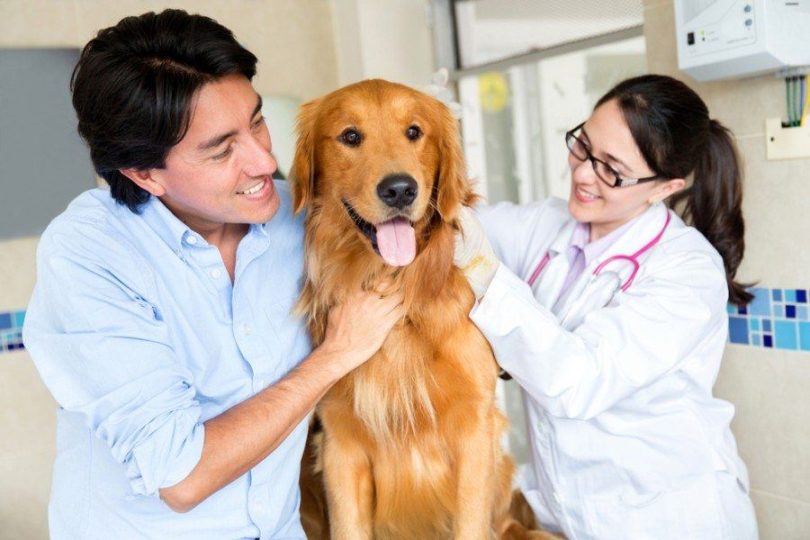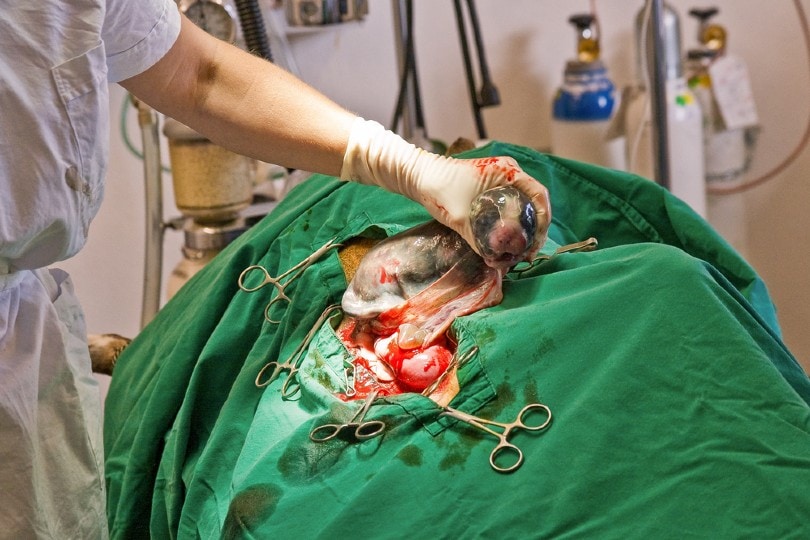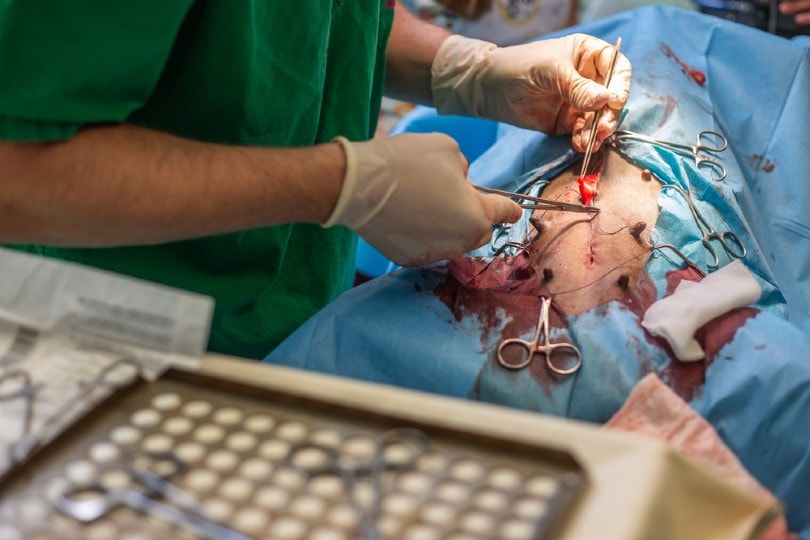
If your dog is pregnant, you may be wondering how long it will be before she has the puppies. We know humans are pregnant for 9 months before the baby is born, but dogs can have several puppies at once, and their gestation periods are quite different from ours.
Dogs are pregnant, on average, for 63 days. This range can vary from 58–68 days and is split up into trimesters, just like human pregnancies. These trimesters are much shorter, though, averaging just 21 days each.
If your dog is currently expecting puppies or if you’d like her to do so in the future, here is what you need to know about the process.
Signs That Your Dog Is Pregnant
Even if it’s a surprise to you, there are signs that your dog may be pregnant before it’s confirmed by a veterinarian. For the first couple of weeks, everything will seem normal. Weight gain is common around week 3 or 4, along with morning sickness due to hormonal changes.
Your dog may seem tired and have less energy than normal. They may change their eating habits, either consuming more or less food, depending on how they are feeling. Around week 4, her mammary glands will begin to swell and may turn red to prepare for milk production.
If you suspect that your dog is pregnant, take her to the vet. They will be able to confirm your dog’s pregnancy, and she will need a physical examination to make sure she’s healthy. A checkup is suggested between 2 and 3 weeks of pregnancy. At 4 weeks pregnant, your dog will be able to have an ultrasound, and the growing puppies can be monitored as they grow. If your dog is examined by a vet after her 4th week of pregnancy, the vet will be able to feel the moving puppies inside of her. The puppies will be roughly the size of walnuts at this point and should only be felt externally by a trained veterinary professional. Trying to feel the puppies yourself may cause damage to them as they are developing.

Can a Dog Take a Pregnancy Test?
A higher level of the hormone relaxin is present in dogs that are pregnant. This level can be checked with a blood test. The hormone is produced as the placenta develops and can be detected between 22 and 27 days of the pregnancy.
Testing for relaxin levels before the dog is 22 days pregnant may result in a false negative pregnancy reading. If you believe that your dog is pregnant but she tests negative between 22 and 27 days, she should be tested one week later to ensure that the negative result is accurate. Your veterinarian may recommend multiple tests if the breeding date is not known.

Can Dogs Have Miscarriages?
Unfortunately, dogs can have miscarriages for various reasons. Sometimes, a positive pregnancy reading doesn’t mean the blood test will still be positive for relaxin as time goes on. A negative reading means the dog has experienced a miscarriage or reabsorption of her litter. Improper nutrition, low hormone levels, infections, fetal defects, and illnesses are all reasons for miscarriages in dogs. If you notice vaginal discharge coming from your dog, take her to the vet immediately. Sometimes, early signs of a potential miscarriage can be detected and stopped by a veterinarian if this dog is treated in time.

Signs of Labor in Dogs
When your dog has been pregnant for 58 days, she can go into labor at any time over the next 10 days. The length of pregnancy can also vary due to the size of the puppies, the number of puppies, and the breed of the mother dog. Signs that she is soon going into labor are:
Any change in behavior during this time should be noted and brought to your vet’s attention if you have any concerns.
Your dog may start to leak milk, and you might be able to see the puppies actively moving inside of her. During weeks 7–9 of her pregnancy, one final vet visit will confirm her health, and you can get an X-ray of her abdomen so you will be able to see how many puppies she’s expecting. This will help you know what to watch when she delivers them.
How Long Is a Dog in Labor?
A dog’s labor is divided into three stages. Being aware of what happens during each will enable you to help the mother dog if she needs assistance and make sure the puppies are as healthy as possible.
Stage One Labor
The first stage of labor is the beginning of contractions and can last anywhere from 6 to 12 hours. The mother dog can display visible signs of discomfort during this stage. Pacing, restlessness, digging, and panting are often seen.
Stage Two Labor
This is where the bulk of the work takes place. Stage two of a dog’s labor includes frequent, strong contractions and the birth of the puppies. When these intense contractions lead to the birth of the first puppy, the rest should be born 45–60 minutes apart, following a 10–30-minute period of straining by the mother.

Sometimes, the mother takes a break from labor, and it’s not uncommon for her to not strain for up to 4 hours. If you expect her to have more puppies and she’s taking a break, note how long it is before she’s contracting again. If you don’t notice any contractions after 4 hours, take her to the veterinarian. She may need assistance delivering the rest of the puppies. The same is true if she strains to deliver a puppy for more than 60 minutes. She should be seen by a veterinarian immediately.
Stage Three Labor
This is the afterbirth stage. The mother dog will usually experience stages two and three with each puppy. The puppy is born, and the afterbirth will come out 5–15 minutes later. This is the placenta and is usually a greenish-black mass of tissue. If several puppies are born in succession, the dog may deliver several placentas afterward. After a placenta is delivered, the mother returns to stage two if puppies are left to deliver. There should be as many placentas delivered as there are puppies. If you are missing a placenta, your dog should see a vet. Undelivered placentas can make your dog sick.
Hours to Puppies
A typical rule of thumb regarding dog labor is 1 hour per puppy. If your dog is pregnant with six puppies, delivering them all should not take more than 6 hours. Labor lasting longer than the expected time should be reported to your vet.

Health Complications
After the mother dog gives birth, she should be monitored closely for anything abnormal. Here are a few things to be aware of:
If you notice any signs of illness in your dog, contact your vet.
How Many Puppies Can a Dog Have?
Dogs can have between one and 12 puppies normally, but the size of the litter will vary depending on the size and breed. The largest puppy litter currently recorded is 24 puppies! A Neapolitan Mastiff delivered 15 male puppies and nine female puppies, breaking the Guinness World Record in 2009.
The average litter size is five to six puppies for all dogs. However, big dogs will have large litters, and small dogs will have few puppies in their litters. For example, a Golden Retriever usually has eight puppies at a time, and their largest known litter is 17 puppies. A Dachshund typically has five puppies at a time, and their largest known litter is eight puppies.

Spaying
Deciding whether to breed your dog is important. Being prepared to help her deliver puppies, keeping her healthy, and then raising the puppies until they find homes is a big responsibility. If this isn’t something that interests you, consider spaying your dog. This ensures that she will not get pregnant with an unwanted litter and that she stays healthy and happy.
Spaying your dog will also limit the number of accidental litters born each year that add to the overpopulation of dogs in the United States.

Conclusion
Dogs are pregnant, on average, for 63 days before delivering puppies. There are three stages of labor involved during delivery. Mother dogs will typically deliver all their puppies within the corresponding number of hours. If they don’t deliver all their puppies during this time or don’t deliver all the placentas, contact your veterinarian.
Many people are not interested in their dog having puppies. If this is the case, the best way to keep your dog healthy and happy is to have her spayed. Female dogs that aren’t going to breed should be spayed to avoid potential health problems and accidental mating.
Related read:
- How Long Is a Corgi Pregnant? Facts & Care Guide
- There’s a Green Discharge From My Pregnant Dog: Should I Worry? Our Vet Answers
Featured Image Credit: Renata Apanaviciene, Shutterstock








